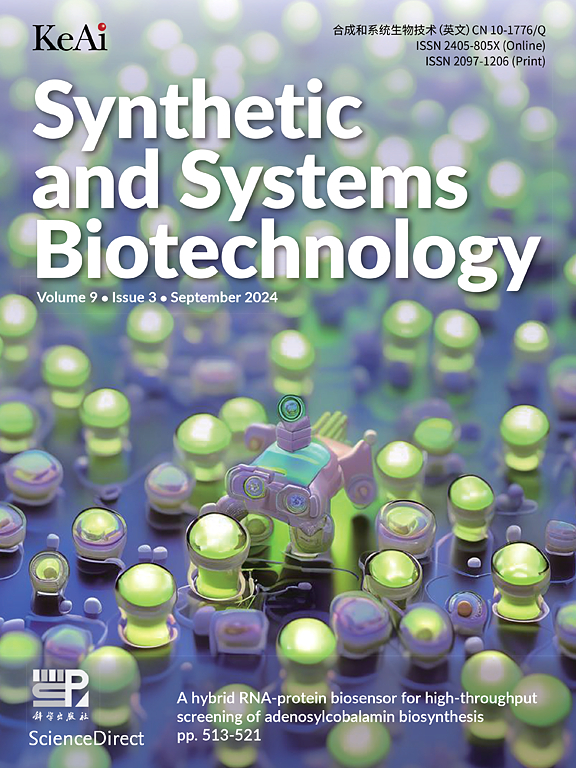Development of ultrasound-visualized tumor-targeting engineered bacteria for precise tumor therapy
IF 4.4
2区 生物学
Q1 BIOTECHNOLOGY & APPLIED MICROBIOLOGY
引用次数: 0
Abstract
In situ imaging diagnosis and precise treatment of deep tumor tissues are hotspots in life sciences and medical research. In recent years, using focused ultrasound to remotely control engineered bacteria for drug release has become one of the methods for precise in vivo drug delivery. However, non-visualized engineered bacteria pose challenges for precise control within the body. Therefore, there is an urgent need for an engineered bacterial vector capable of deep tissue imaging to precisely locate bacteria in vivo. Acoustic reporter genes (ARGs) are biological elements used for deep tissue imaging, with gene clusters over 8 kb. However, ARGs are often tested on plasmids, which hinders stable expression in vivo and limits the space for inserting components that regulate drug release. Therefore, we used the attenuated Salmonella typhimurium VNP20009, known for its tumor-targeting ability, as the chassis bacteria. By using CRISPR-Cas9 technology, we inserted ARGs into the genome and optimized the promoter strength and copy number for ARG expression, constructing ultrasound-visible engineered bacteria expressing gas vesicles on the genome. Additionally, by knocking out the stress protein gene htrA in VNP20009, we increased the maximum injection dose by tenfold and the tumor specificity by a hundredfold. The constructed ultrasound-visible engineered bacteria can stably synthesize gas vesicles and output ultrasound signals while directly carrying drug plasmids for tumor therapy. Our research provides an effective vector for diagnosis and precise treatment.

用于肿瘤精确治疗的超声可视化肿瘤靶向工程细菌的研究进展
深部肿瘤组织的原位成像诊断和精准治疗是目前生命科学和医学研究的热点。近年来,利用聚焦超声远程控制工程细菌释放药物已成为体内精确给药的方法之一。然而,非可视化的工程细菌对体内的精确控制提出了挑战。因此,迫切需要一种能够进行深层组织成像的工程细菌载体来精确定位体内细菌。声学报告基因(ARGs)是用于深层组织成像的生物元件,其基因簇超过8kb。然而,ARGs通常在质粒上进行测试,这阻碍了体内稳定表达,并限制了插入调节药物释放成分的空间。因此,我们选用以肿瘤靶向能力闻名的减毒鼠伤寒沙门氏菌VNP20009作为底盘细菌。我们利用CRISPR-Cas9技术将ARGs插入基因组,并优化ARG表达的启动子强度和拷贝数,在基因组上构建超声可见的表达囊泡的工程菌。此外,通过敲除VNP20009的应激蛋白基因htrA,我们将最大注射剂量提高了10倍,肿瘤特异性提高了100倍。所构建的超声可见工程菌能够稳定地合成气体囊泡并输出超声信号,同时直接携带药物质粒用于肿瘤治疗。我们的研究为诊断和精确治疗提供了有效的载体。
本文章由计算机程序翻译,如有差异,请以英文原文为准。
求助全文
约1分钟内获得全文
求助全文
来源期刊

Synthetic and Systems Biotechnology
BIOTECHNOLOGY & APPLIED MICROBIOLOGY-
CiteScore
6.90
自引率
12.50%
发文量
90
审稿时长
67 days
期刊介绍:
Synthetic and Systems Biotechnology aims to promote the communication of original research in synthetic and systems biology, with strong emphasis on applications towards biotechnology. This journal is a quarterly peer-reviewed journal led by Editor-in-Chief Lixin Zhang. The journal publishes high-quality research; focusing on integrative approaches to enable the understanding and design of biological systems, and research to develop the application of systems and synthetic biology to natural systems. This journal will publish Articles, Short notes, Methods, Mini Reviews, Commentary and Conference reviews.
 求助内容:
求助内容: 应助结果提醒方式:
应助结果提醒方式:


